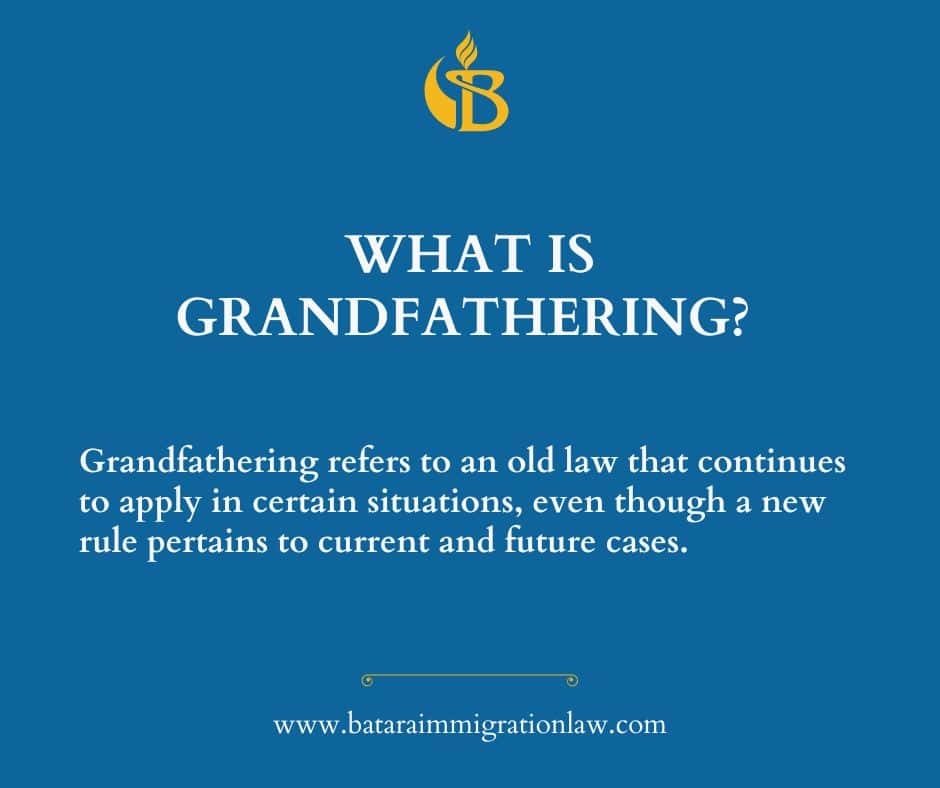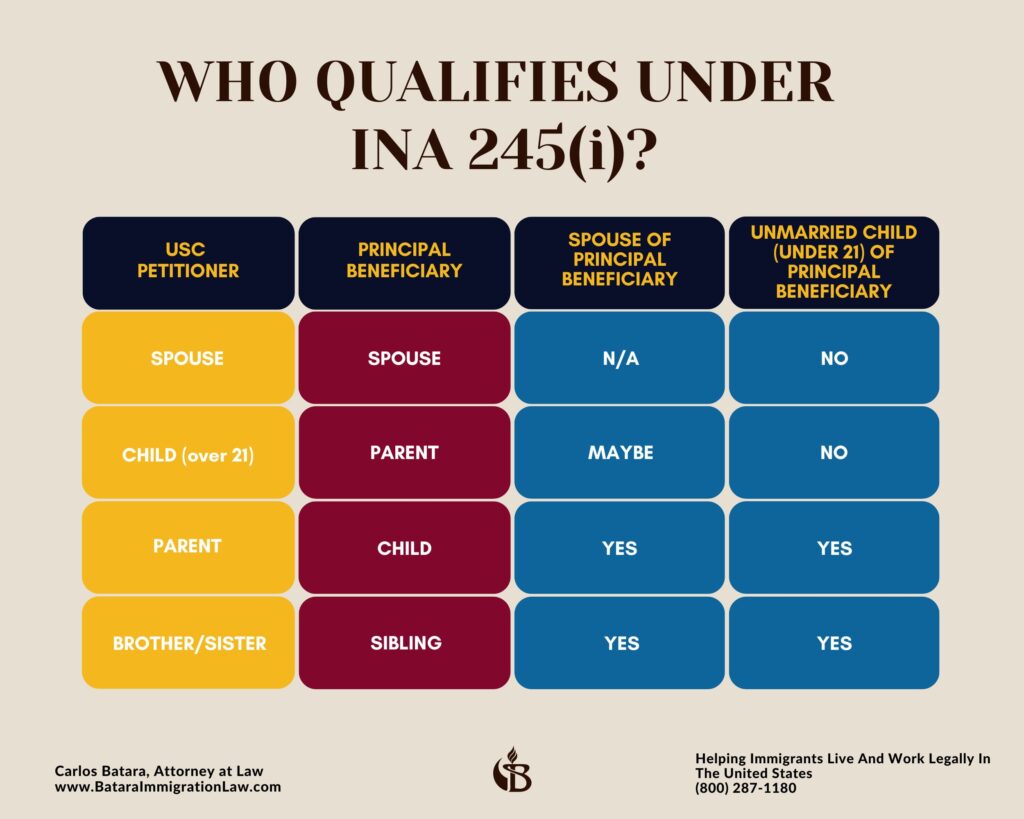
Reviving Old Immigrant Family Petitions
Many clients who visit our offices had family and relative petitions for immigration benefits filed on their behalf a long time ago. They often do not know the status of the paperwork. They do not know if the family petition has been canceled.
They do not know if their paperwork is still valid and if they can still apply for their green cards. They do not know if they must start over again.
If this is your situation, you may be in luck. Sometimes, your old I-130 family petition can help you qualify for a green card today.

Table Of Contents
- Two Paths To Green Cards: Adjustment Of Status And Consular Processing
- Adjustment Of Status Under INA 245(i)
- INA 245(i) Grandfathering Rights
- Who Benefits From 245(i) Grandfathering: Principal And Derivative Beneficiaries
- When Are After-Acquired Spouses And Children Grandfathered?
- What Is An Approvable When Filed I-130 Visa Petition?
- More Details: INA 245(i) Cut-Off Dates, Physical Presence, And Penalty Fees
- The Ongoing Importance Of Reinstating INA 245(i) And Extending The Cut-Off Date
Two Paths To Green Cards: Adjustment Of Status And Consular Processing
For immigrants living in the United States, there are two paths to winning permanent residence: adjustment of status and consular processing.
Adjustment Of Status (Interview Inside The United States)
Some immigrants qualify for green card interviews in the United States. This is known as adjustment of status. Simply stated, this means you are trying to change your immigrant status to a legal resident.
Adjustment of status interviews take place at a local U.S. Citizenship and Immigration Services office.
Consular Processing (Interview In Immigrant’s Home Country)
On the other hand, if immigrants living in the United States do not meet the requirements for adjustment of status, they must attend green card interviews in their home country.
This is known as consular processing.
Editor’s Note: If the immigrant lives outside the U.S., consular processing is the only path for immigrating to the United States. In this article, we are focusing on immigrants living in the U.S.
Adjustment Of Status Under INA 245(i)
The rules for adjustment of status are codified in INA section 245(a). To be eligible for adjustment of status under this section of law, an immigrant must show:
- They entered lawfully. This means at the time of entry, you were inspected, then admitted or paroled into the U.S. If you entered the country with a valid temporary visa, such as a tourist or student visa, even if it expired, your entry is still lawful.
- They have never been out of legal status. For instance, when a tourist or student remains in the U.S. past their expiration date, they have overstayed their visa and no longer are in legal status.
- They have never worked with employment authorization.
These requirements preclude many immigrants from seeking green cards via an interview in the United States. They must attend an interview for permanent residence at the U.S. Embassy or Consular Office in their home country.
Yet, returning is not guaranteed. Generally, if immigrants have resided in the United States without permission for more than 180 days, they must win an I-601A waiver to be allowed re-entry. They are subject to being barred, depending on how long they lived here, for 3 years, 10 years, or permanently,
The waiver is based on showing extreme hardship to a U.S. citizen spouse or parent if they cannot return – a difficult, difficult standard to meet.
However, there is an exception for some immigrants.
An old law, INA 245(i), can help some immigrants who are ineligible under INA 245(a), to qualify for adjustment of status – even though the law ended many years ago.
This is known as 245(i) adjustment of status.
To be sure, this provision does not confer any immigration benefits.
It simply allows an immigrant to adjust their status in the United States through an interview in the United States – and not leave the country – even if they entered without inspection, overstayed a visa expiration date, or worked without permission.
In addition, immigrants who seek adjustment under 245(i) are required to pay a $1,000 “penalty fee” that is not imposed on 245(a) applicants.

INA 245(i) Grandfathering Rights
Here’s the key to success.
April 30, 2001.
In order to qualify for 245(i) adjustment, an immigrant must prove that a family-based I-130 Petition was filed no later than April 30, 2001.
This petition has to meet the following requirements:
- The immigrant was either the principal or derivative beneficiary of the petition
- The I-130 petition was either approved or approvable when it was filed
If you can show that you have a valid petition meeting these criteria, then your current application for permanent residence may proceed under grandfathering.
Grandfathering refers to an old law that continues to apply in certain situations, even though a new rule pertains to current and future cases.
In legal jargon, those who are exempt from the new rule have “grandfather rights” to the old law or to have been “grandfathered into” the old law.
Stated more simply, grandfathering allows someone to continue to use an old rule which a new law makes illegal.
Here, immigrants with evidence of a valid I-130 petition filed before April 30, 2001 can utilize that petition over 20 years later to help them adjust their status in the U.S. without having to return to their home country.
Who Benefits From 245(i) Grandfathering: Principal And Derivative Beneficiaries
Allow me to explain the two requirements noted above. We’ll start with a short discussion on who is a principal beneficiary and who is a derivative beneficiary.
When a family based immigrant relative petition is filed, there are two parties involved:
- Petitioner – The petitioner is the U.S. citizen or lawful permanent resident sponsoring a relative for a green card.
- Beneficiary – The immigrant who is being sponsored by the petitioner.
There are two classes of beneficiaries:
- Principal Beneficiary – The specific person for whom an immigrant relative visa petition is filed – the specific immigrant listed on the I-130 petition as the beneficiary.
- Derivative Beneficiary – A spouse or unmarried child (under 21) of the principal beneficiary who the petitioner could not sponsor directly.
(If the U.S. citizen or lawful permanent resident who petitioned for the principal beneficiary could have directly filed a petition for you, you cannot be a derivative beneficiary.)
Here’s an example.
In February 2001, Grace, an immigrant from Ghana, brought Emmanuel, her 8-year old son, to the U.S. on a visitor visa to see her relatives living in the San Francisco area.
A few months later, prior to April 30, 2001, Josephine, a United States citizen, filed an I-130 petition for her sister, Grace. Grace and Emmanuel remained in the U.S. without permission.
Immigration law does not allow aunts or uncles to petition nephews or nieces. Thus, as the aunt of Emmanuel, Josephine could not directly file a petition for him.
Based on the petition filed by Josephine, Grace is considered a principal beneficiary. Emmanuel, as the son of Grace, is a derivative beneficiary.
Now, over 20 years later, Emmanuel can use the petition filed by Josephine for his mother to seek adjustment of status to permanent residence as a derivative beneficiary under the INA 245(i) grandfathering provisions.
When Are After-Acquired Spouses And Children Grandfathered?
For several years, immigration courts and agencies have struggled with the grandfathering 245(i) rights of after-acquired spouses and unmarried children.
The issue has centered on three different interpretations of “after-acquired” spouses and children.
Are grandfathering rights limited to spouses married to principal beneficiaries and children born to principal beneficiaries
- (a) before the original I-130 was filed
- (b) before the April 30, 2001 cut-off date, or
- (c) after the cut-off date but before the principal beneficiary adjusted status?
In Matter of Triana, the Board of Immigration Appeals clarified the second option was the correct interpretation.
Accordingly, “grandfathered derivatives” include spouses married and children born to the principal beneficiary on or before April 30, 2001, and not simply those married or born before the visa petition was filed.
They have full 245(i) rights and can use grandfathering law to seek adjustment on an independent basis without the principal beneficiary.
Editor’s Note: Unfortunately, the U.S. Citizenship and Immigration Services Policy Manual still defines “after-acquired” spouses and children under the first interpretation.
When filing for 245(i) adjustment, both immigrants and their representatives need to be vigilant and ready to challenge the USCIS view.
On the other hand, spouses whose marriage to derivative beneficiaries occurred after, as well as children born to derivative beneficiaries after, the April 30, 2001 date have more limited options.
They do not have grandfathering rights under INA 245(i).
They are allowed to seek permanent residence under section 245(i) – but not independent from the principal beneficiary’s adjustment.
Because they do not have independent 245(i) rights, they cannot be grandfathered for a green card on their own.
In other words, they can be grandfathered under the principal beneficiary’s 245(i) rights and can adjust status only through one of the following processes:
(a) They “accompany” the principal beneficiary and seek to adjust their status together.
(b) They “follow to join” the principal beneficiary within six months of the date when the principal beneficiary became a permanent resident.
What Is An Approvable When Filed
I-130 Visa Petition?

Under INA 245(i), the government adopts an “alien-based” reading of grandfathering. This mean that the I-130 filed on or before April 30, 2001 had be “approvable when filed”.
To be approvable when filed, the petition has to be (a) properly filed, (b) meritorious in fact, and (c) non-frivolous
“Properly-filed”, the first prong, means the petition was signed by the petitioner, submitted with the appropriate filing fee, and postmarked on or before April 30, 2001.
Unfortunately, as a green card lawyer, I have seen cases where careless mistakes made many years ago destroyed the chances of otherwise deserving immigrants’ opportunity to win permanent residence.
In one such matter, after obtaining a copy of an immigrant’s old filings, I had to explain that a $10.00 filing fee mistake in his original submission caused the I-130 visa petition to be returned.
Although the family corrected the error and paid the appropriate fee, it was received six days after the April 30, 2001 cut-off date. As a result, the leniency of section 245(i) was not available to them.
More recently, the Board examined the “meritorious in fact” and “non-frivolous” prongs of the “approvable when filed” provisions in the Triana case.
The case involved a permanent resident who filed an I-130 petition for his daughter that was mistakenly approved. (Lawful permanent residents cannot immigrate married daughters over 21.)
As a result, the BIA noted that the visa petition did not merit a legal victory, even though it had been approved.
Conversely, even if an old I-130 visa petition was denied, withdraw, or revoked does not mean it was not “approvable when filed”.
Take a principal beneficiary who divorced the U.S. spouse who had petitioned for her and now seeks to adjust status under section 245(i). She is still eligible.
Or a derivative beneficiary, like Emmanuel, who is no longer a minor child. He is now over 21. He can continue to utilize 245(i) to win a green card at the age of 30, 35, 40, or older.
In short, neither an approved nor denied I-130 petition is the final word on whether the petition was “approvable when filed”.
Rather, when filing an INA 245(i) adjustment, the immigrant must prove that on the date of the I-130 filing – not on the date of the adjustment application – the old visa petition was approvable.
More Details: INA 245(i) Cut-Off Dates, Physical Presence, And Penalty Fees
Although our discussion has centered on April 30, 2001, there are actually two different cut-off dates for filing family-based I-130 petitions under INA 245(i).
- January 14, 1998
- April 30, 2001
A little history is in order.
In 1997, Congress ended the 245(i) program but created a provision for grandfathering for approvable petitions filed before January 14, 1998. Three years later, as part of the Legal Immigration Family Equity (LIFE) Act in 2000, Congress extended the cut-off filing date for 245(i) to April 30, 2001.
The major difference between the two filing dates pertains to physical presence.
- For grandfathered 245(i) eligibility related to I-130 petitions filed under the January 14, 1998 cut-off date, there is no physical presence requirement.
-
- For grandfathered 245(i) eligibility related to I-130 petitions filed under the April 30, 2001 cut-off date, the principal beneficiary must have been physically present in the United States on December 21, 2000.
Under either cut-off date, immigrants who apply for adjustment under 245(i) are required to pay a $1,000 penalty fee.
Click here for various examples how 245 works and helps immigrants win permanent residence.
The Ongoing Importance Of Reinstating INA 245(i) And Extending The Cut-Off Date
Prior to the 9/11 terrorist attack, most immigration experts felt that the April 29, 2001 cut-off date would be extended.
Its importance, as a potential path to legalization, has been magnified by the harshness of the Illegal Immigration Reform And Immigrant Responsibility (IIRAIRA) Act, a law enacted in 1996, which imposed 3 year, 10 year, and permanent bars to reentry upon immigrants, who left the U.S. to attend green card interviews abroad.
In his first campaign for president, Obama repeatedly told audiences that “It’s vital we bring immigrant families living in the U.S. out of the shadows and provide them with a pathway to citizenship.”
Those of us practicing immigration law at the time thought one of his first actions would be to push for a change of section 245(i) of the Immigration and Nationality Act.
Unfortunately, that did not happen.
The battle to revive old immigrant family petitions continues.
If Congress reinstated the LIFE Act – and updated the cut-off date of April 30, 2001 – studies estimate 1.4 million immigrants married to U.S. citizens or green card holders would be eligible to apply for permanent residence without having to leave the country.
This does not mean all 1.4 million would win their cases.
It just means there would be a mechanism under which they could apply for adjustment of status at local immigration offices..
Two benefits would accrue to government authorities.
It would reduce the USCIS huge backlog of cases and produce billions of dollars for the immigration agency’s coffers.
Some discussions of modifying the INA 245(i) dates have suggested raising the penalty fee to $2,500 or higher per application.
Many of my pro-immigrant colleagues would balk at such an increase.
I would not.
In my view, the price of freedom, security, and stability, enabling immigrants to come out of the shadows and live a life of normalcy with their spouses and children, cannot be judged by mere dollars and cents.
I remain hopeful, sooner or later, Congress will see fit to allow such families to become full-fledged members of our society and contribute to our country’s well-being.
With your support, we can make this happen.
Ready to take a serious and honest look at the strengths and weaknesses of your immigration case? Let’s get started with a personalized strategy and planning session . . .




